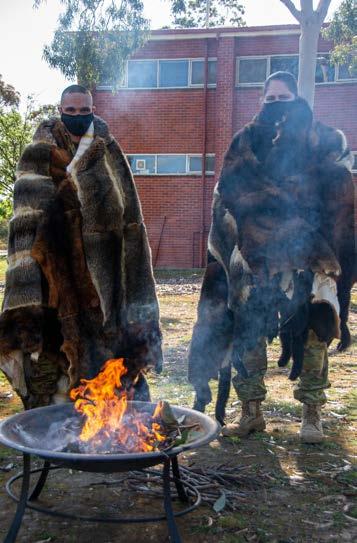
7 minute read
Extravagance amid plenty: replacing the Aussie Tigers
Early replacement of the Australian Army’s 22 Airbus Tiger attack helicopters looks like a severe mistake. More defence capability—more urgently needed capability—could be bought by spending the money elsewhere.
The Tigers don’t need replacing. And 2021 looks like bad timing to be recommitting to the concept of the manned attack helicopter. It would have been better to wait.
Advertisement
Defence Minister Linda Reynolds announced selection of the Boeing AH-64E Apache for this project on 15 January. So there’s now next to no chance that the acquisition will be stopped. But it’s still worth reviewing andrememberingasaclass-Aexample of loose spending of a plentiful defence budget—an unjustified extravagance as China becomes ever more capable of upending the East Asian order and, potentially, directly threatening Australia.
Reynolds omitted any mention of how much the planned 29 Apaches would cost—as well she might, since the figure noted in the 2020 force structure plan is a hefty $3.4–5.1 billion.
Apaches will bring a greater ability to gather battlefield information, strike behind enemy lines and support infantry in combat. ASPI’s Malcolm Davis sets out the type’s advantages here. But the project, Land 4503, is not merely adding those helicopters and their capabilities to the Australian Army; it is also subtracting what’s already in service.
The Tigers are not obsolete. They are performing well. Their running costs are high but stable and, we can reasonably hope, will fall over time as operators and suppliers find new ways of attending to problems. Thanks to years of poor fleet performance, the airframes are still fresh, so a steep late-life rise in costs is many years away. The training and support setup for the Tiger is in place. Soldiers are increasingly familiar with what they can do with these machines.
So Land 4503 is nothing like a typical procurement case, in which old equipment is unviable, increasingly unserviceable,sufferingfromterminally rising running costs and imminently unsafe.
Meanwhile, seeing better ways of spending $3.4–5.1 billion is not hard.
In the early 2020s, just about every Australian defence procurement decision can be judged against a goldstandard alternative: promptly buying moreLockheedMartinF-35Lightnings, an easy move that would yield an obvious and powerful increment to national defence capacity. The force structure plan puts the cost of inducting the currently planned 72 F-35As at $17 billion. So a crude pro rata calculation using the $4.25-billion midpoint of the Land 4503 allocation tells us that Australia could have 18 additional F-35As, enough for another squadron, instead of getting 29 Apaches minus 22 Tigers.
In fact, acquisition of 18 fighters would probably not use the whole Land 4503 budget, since F-35 production costs are falling as volumes increase and since Australia has paid for the overheads of operating the type. There would be money left over to cover necessary additions to bases and training capacity (but maybe not running costs).
A discussion such as this risks descending into an author’s wish list. So let’s instead consider governmentidentified priorities for defence acquisitions—projects which, we can see, could be brought forward or expanded with the Land 4503 money. Such projects are those for land-based anti-ship missiles, air-launched strike capability and deployable defence systems against ballistic and highspeed missiles. All look far more likely to get the attention of the Chinese military than an upgraded attackhelicopter force.
The odds are that the army is thinking of the Apaches mainly for expeditionary operations, not for defending Australia. This underlines a considerable advantage of the AH-64E over the Tiger: ease of operation alongside the US Army, which also uses the Boeing type. It’s not a conclusive argument, however. If the Tiger isn’t considered easily deployable to, say, the Middle East, there’s an easy solution: don’t deploy it; rely on friends’ battlefield airpower instead. No ally expects Australia to turn up with everything needed for a jointly executed mission.
Finally, the timing of this acquisition is historically bad. The manned attack helicopter is not an obsolete concept but it has been heading that way. Improved ground-based defences are raising risks for these hefty machines just as drones are increasingly capable of performing battlefield aviation missions.
No one is yet giving up on the manned attack helicopter, and indeed it may turn out to have decades of viability ahead of it, working with drones that take the greatest risks. But Australia doesn’t need to make that judgement now. Because the country hasaforceofattackhelicoptersthatwill be serviceable for a decade or more, it can afford to wait and watch technical developments. It doesn’t immediately need to make a 30-year recommitment to the attack-helicopter concept, as it will by ordering 29 Apaches in the early 2020s.
Bradley Perrett www.aspistrategist.org.au/
National Wharf Cartage
Our national coverage ensures continuity of service and reduces time and associated administration costs when working with multiple providers.
Depot Services
On-site fumigation, quarantine inspection, container staging options, packaging, unpacking & re-delivery services eliminate 3rd party involvement, reducing your lead times and associated costs.

Container Tracing & Visibility
Our online portal (Mainchain) gives you and your customers real time information across all legs of your containers journey.

owenstransport.com.au | (02) 9101 8500


Product Solutions for Intelligent Traffic Systems
AGD make easy to intergrate globally compatible ITS product solutions.
Telephone: (02) 9653 9934 sales@agd-systems.com.au | wwwagd-systems.com.au Unit 17/15 Valediction Rd, Kings Park NSW 2148
Invaluable place for a yarn
SoldiersandvisitorstothePuckapunyal Military Area will benefit from a yarning circle, which was opened by Indigenous Elder Aunty Joanne from the local Taungurung Land and Waters Council during last year’s NAIDOC Week activities.
A yarning circle is a culturally appropriate place to meet and hold ceremonies, and also is the practice of speaking and listening from the heart.
Aunty Joanne, who has been instrumental in providing support, guidance and advocacy to Army’s Indigenous soldiers, trainees and APS staff at Puckapunyal, said the yarning circle was invaluable for mentoring the cultural wellbeing of Army’s soldiers.
“I am pleased to have been able to work together with the cooperation and respect between the Puckapunyal Army people and the local Aboriginal networks over the past year,” she said.
“This has been reflected by the thoughtful siting and construction of this yarning circle.”
Senior ADF Officer Puckapunyal, Colonel David McCammon, said the initiative enabled further cooperation between Army and local Indigenous groups.
“It is important that we continue to nurture our soldiers and officers while they are posted to or attending courses at Puckapunyal,” Colonel McCammon said.
Prior to a site being established at Puckapynyal, the Army School of Transport held a yarning circle, led by Elders Aunty Joanne and Uncle Shane.
Trainees and Elders exchanged stories, and guidance was offered and exchanged on various cultural aspects.
This was followed by a smoking ceremony to help the trainees move on to the next part of their careers.
At this time, the trainees presented two Indigenous-themed paintings to the school, which acknowledged the trainees’ backgrounds and future service within Army and the Royal Australian Corps of Transport.
Commanding Officer of the Army School of Transport, Lieutenant Colonel Clarke Brown, said the paintings were a great initiative and would help future Indigenous trainees knowing that others had travelled their journey.
“The importance of knowing others who have been here before was highlighted when a trainee told me that she felt more a part of the Indigenous community and more connected to her Indigenous heritage since joining Army,” Lieutenant Colonel Brown said.
“It is very important to understand and appreciate the cultural sense of community Indigenous members bring with them.”
Uncle Shane said it was a great


(l-r) Australian Army Privates, Brodie Lawton and Karleisha Blair, from Army School of Transport, are wrapped in traditional possum cloaks that are worn in the presence of traditional land owners, at Puckapunyal, Victoria. Below: Brodie Lawton Defence images.
opportunity for the Taungurung people to be involved with other mobs from all over Australia and it was an honour to be part of the trainees’ journeys.
Local formation Indigenous liaison officer Major Peta Langbehn said the establishment of a yarning circle highlighted the local support measures available and the positive connection with local Indigenous Elders.
“Uncle Shane and Aunty Joanne have excelled in the support they have been able to provide,” Major Langbehn said.
“Yarning circles provide a way and place for people to meet, conduct ceremonies, connect with each other, and provide a support network.
“We look forward to continuing to work with our local Elders, such as Aunty Joanne and Uncle Shane, to be able to offer support to our Indigenous soldiers and APS in a culturally appropriate way.”



